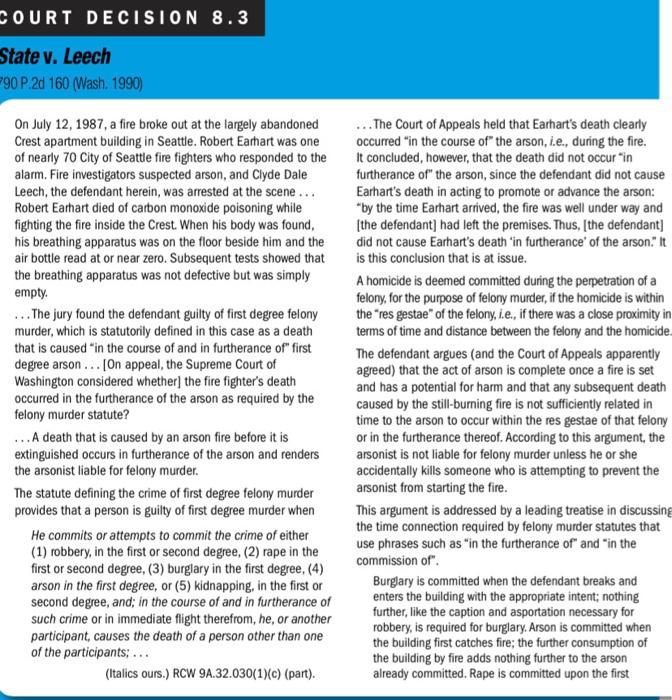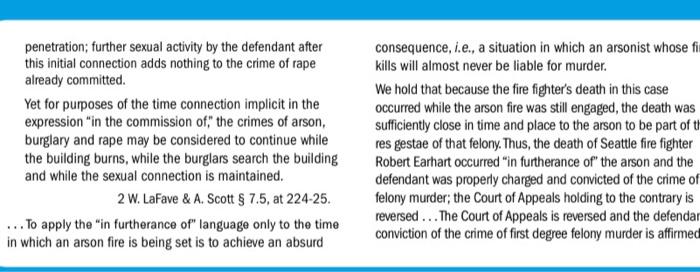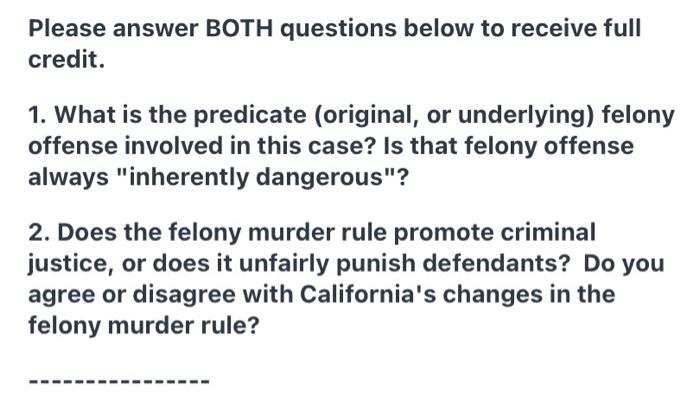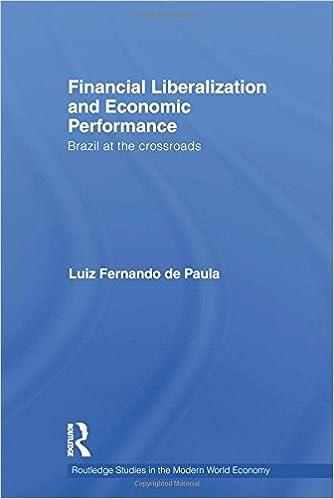300 words

COURT DECISION 8.3 State v. Leech 90 P 2d 160 (Wash. 1990) On July 12, 1987, a fire broke out at the largely abandoned Crest apartment building in Seattle. Robert Earhart was one of nearly 70 City of Seattle fire fighters who responded to the alarm. Fire investigators suspected arson, and Clyde Dale Leech, the defendant herein, was arrested at the scene ... Robert Earhart died of carbon monoxide poisoning while fighting the fire inside the Crest. When his body was found, his breathing apparatus was on the floor beside him and the air bottle read at or near zero. Subsequent tests showed that the breathing apparatus was not defective but was simply empty. ... The jury found the defendant guilty of first degree felony murder, which is statutorily defined in this case as a death that is caused in the course of and in furtherance of first degree arson ... [On appeal, the Supreme Court of Washington considered whether the fire fighter's death occurred in the furtherance of the arson as required by the felony murder statute? ... A death that is caused by an arson fire before it is extinguished occurs in furtherance of the arson and renders the arsonist liable for felony murder. The statute defining the crime of first degree felony murder provides that a person is guilty of first degree murder when He commits or attempts to commit the crime of either (1) robbery, in the first or second degree, (2) rape in the first or second degree, (3) burglary in the first degree, (4) arson in the first degree, or (5) kidnapping, in the first or second degree, and; in the course of and in furtherance of such crime or in immediate flight therefrom, he, or another participant, causes the death of a person other than one of the participants:... (Italics ours.) RCW 9A.32.030(1)(c) (part). ... The Court of Appeals held that Earhart's death clearly occurred in the course of the arson, i.e., during the fire. It concluded, however, that the death did not occur in furtherance of the arson, since the defendant did not cause Earhart's death in acting to promote or advance the arson: *by the time Earhart arrived, the fire was well under way and (the defendant) had left the premises. Thus, (the defendant] did not cause Earhart's death in furtherance of the arson." It is this conclusion that is at issue. A homicide is deemed committed during the perpetration of a felony, for the purpose of felony murder, if the homicide is within the res gestae" of the felony, i.e., if there was a close proximity in terms of time and distance between the felony and the homicide The defendant argues (and the Court of Appeals apparently agreed) that the act of arson is complete once a fire is set and has a potential for harm and that any subsequent death caused by the still-burning fire is not sufficiently related in time to the arson to occur within the res gestae of that felony or in the furtherance thereof. According to this argument, the arsonist is not liable for felony murder unless he or she accidentally kills someone who is attempting to prevent the arsonist from starting the fire. This argument is addressed by a leading treatise in discussing the time connection required by felony murder statutes that use phrases such as in the furtherance of and in the commission of". Burglary is committed when the defendant breaks and enters the building with the appropriate intent; nothing further, like the caption and asportation necessary for robbery, is required for burglary. Arson is committed when the building first catches fire; the further consumption of the building by fire adds nothing further to the arson already committed. Rape is committed upon the first penetration; further sexual activity by the defendant after this initial connection adds nothing to the crime of rape already committed. Yet for purposes of the time connection implicit in the expression in the commission of the crimes of arson, burglary and rape may be considered to continue while the building burns, while the burglars search the building and while the sexual connection is maintained. 2 W. Lafave & A. Scott $ 7.5, at 224-25. ... To apply the "in furtherance of language only to the time in which an arson fire is being set is to achieve an absurd consequence, i.e., a situation in which an arsonist whose fi kills will almost never be liable for murder. We hold that because the fire fighter's death in this case occurred while the arson fire was still engaged, the death was sufficiently close in time and place to the arson to be part of t res gestae of that felony. Thus, the death of Seattle fire fighter Robert Earhart occurred "in furtherance of the arson and the defendant was properly charged and convicted of the crime of felony murder; the Court of Appeals holding to the contrary is reversed ... The Court of Appeals is reversed and the defendar conviction of the crime of first degree felony murder is affirmed Please answer BOTH questions below to receive full credit. 1. What is the predicate (original, or underlying) felony offense involved in this case? Is that felony offense always "inherently dangerous"? 2. Does the felony murder rule promote criminal justice, or does it unfairly punish defendants? Do you agree or disagree with California's changes in the felony murder rule? COURT DECISION 8.3 State v. Leech 90 P 2d 160 (Wash. 1990) On July 12, 1987, a fire broke out at the largely abandoned Crest apartment building in Seattle. Robert Earhart was one of nearly 70 City of Seattle fire fighters who responded to the alarm. Fire investigators suspected arson, and Clyde Dale Leech, the defendant herein, was arrested at the scene ... Robert Earhart died of carbon monoxide poisoning while fighting the fire inside the Crest. When his body was found, his breathing apparatus was on the floor beside him and the air bottle read at or near zero. Subsequent tests showed that the breathing apparatus was not defective but was simply empty. ... The jury found the defendant guilty of first degree felony murder, which is statutorily defined in this case as a death that is caused in the course of and in furtherance of first degree arson ... [On appeal, the Supreme Court of Washington considered whether the fire fighter's death occurred in the furtherance of the arson as required by the felony murder statute? ... A death that is caused by an arson fire before it is extinguished occurs in furtherance of the arson and renders the arsonist liable for felony murder. The statute defining the crime of first degree felony murder provides that a person is guilty of first degree murder when He commits or attempts to commit the crime of either (1) robbery, in the first or second degree, (2) rape in the first or second degree, (3) burglary in the first degree, (4) arson in the first degree, or (5) kidnapping, in the first or second degree, and; in the course of and in furtherance of such crime or in immediate flight therefrom, he, or another participant, causes the death of a person other than one of the participants:... (Italics ours.) RCW 9A.32.030(1)(c) (part). ... The Court of Appeals held that Earhart's death clearly occurred in the course of the arson, i.e., during the fire. It concluded, however, that the death did not occur in furtherance of the arson, since the defendant did not cause Earhart's death in acting to promote or advance the arson: *by the time Earhart arrived, the fire was well under way and (the defendant) had left the premises. Thus, (the defendant] did not cause Earhart's death in furtherance of the arson." It is this conclusion that is at issue. A homicide is deemed committed during the perpetration of a felony, for the purpose of felony murder, if the homicide is within the res gestae" of the felony, i.e., if there was a close proximity in terms of time and distance between the felony and the homicide The defendant argues (and the Court of Appeals apparently agreed) that the act of arson is complete once a fire is set and has a potential for harm and that any subsequent death caused by the still-burning fire is not sufficiently related in time to the arson to occur within the res gestae of that felony or in the furtherance thereof. According to this argument, the arsonist is not liable for felony murder unless he or she accidentally kills someone who is attempting to prevent the arsonist from starting the fire. This argument is addressed by a leading treatise in discussing the time connection required by felony murder statutes that use phrases such as in the furtherance of and in the commission of". Burglary is committed when the defendant breaks and enters the building with the appropriate intent; nothing further, like the caption and asportation necessary for robbery, is required for burglary. Arson is committed when the building first catches fire; the further consumption of the building by fire adds nothing further to the arson already committed. Rape is committed upon the first penetration; further sexual activity by the defendant after this initial connection adds nothing to the crime of rape already committed. Yet for purposes of the time connection implicit in the expression in the commission of the crimes of arson, burglary and rape may be considered to continue while the building burns, while the burglars search the building and while the sexual connection is maintained. 2 W. Lafave & A. Scott $ 7.5, at 224-25. ... To apply the "in furtherance of language only to the time in which an arson fire is being set is to achieve an absurd consequence, i.e., a situation in which an arsonist whose fi kills will almost never be liable for murder. We hold that because the fire fighter's death in this case occurred while the arson fire was still engaged, the death was sufficiently close in time and place to the arson to be part of t res gestae of that felony. Thus, the death of Seattle fire fighter Robert Earhart occurred "in furtherance of the arson and the defendant was properly charged and convicted of the crime of felony murder; the Court of Appeals holding to the contrary is reversed ... The Court of Appeals is reversed and the defendar conviction of the crime of first degree felony murder is affirmed Please answer BOTH questions below to receive full credit. 1. What is the predicate (original, or underlying) felony offense involved in this case? Is that felony offense always "inherently dangerous"? 2. Does the felony murder rule promote criminal justice, or does it unfairly punish defendants? Do you agree or disagree with California's changes in the felony murder rule










